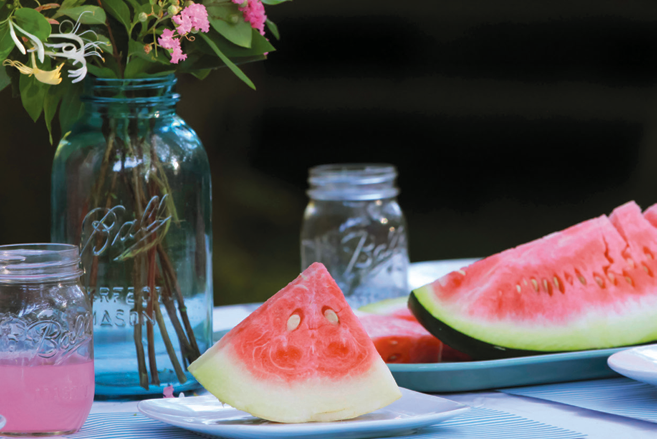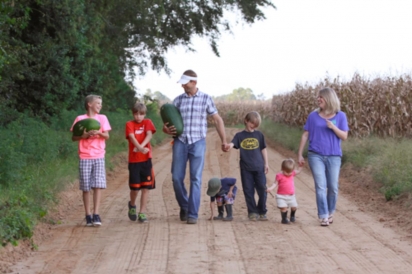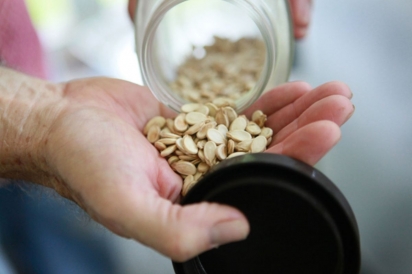Watermelon, the Ultimate Late-Summer Party Favor
When the barometer starts rising and we edge near the summer-fun holidays, I start digging in the pantry to take inventory of my picnic and outdoor fare—paper plates, baskets, checkered tablecloths, cups, glasses, colorful tableware. All of these will accompany the summer garden bounty that our Lowcountry sandy soil offers up. Along with those platters of grilled steaks, brats and fresh skewered local shrimp, I can’t think of a more pleasing table than one heaped with bowls of our sun-ripened summer fruits. Plums, peaches, blackberries, blueberries and cantaloupes are all ripening on the vines this very minute. But the all-time picnic favorite is a late-bloomer, slowly orbing and filling its concave with juices and brimming flavor into the dog days of summer—watermelon, the party favor of the picnic.
I have a confession that may disallow me from having a “Native” sticker on my car: I don’t like watermelon. But, I love everything about it. My favorite summer memories revolve around outdoor gatherings that had the barrel-shaped beauties icing down in kiddie pools and tin tubs. Some of the best neighborhood moms would walk out a screen door and just split one open right on newspaper-covered steps for us yard kids. Barefoot boys and girls darted to and fro in grass-free yards beneath the draping oaks with watermelon-drizzled chests, legs and feet. Seed spitting was an art and accidental seed swallowing was conversation for days after.
Because I didn’t like watermelon —and everyone knew it—I became the most popular gal at the kiddie table. I can’t count how many times I had someone whisper in my ear. “Can I have your piece of watermelon?”
I’ve decided to test my palate once again this year. But this time I am going to try what I hear is our region’s best watermelon—the Bradford watermelon. Sweet with a juicy pulp, this is a late-season melon. So, although I will crack a hull or two for others during the summer picnics, I will anxiously await this striped beauty in August for my enjoyment.
The Bradford watermelon has been mentioned in several press releases over the past few years after the seeds, thought to be extinct, piqued the curiosity of Nat Bradford of Seneca, South Carolina. Bradford stumbled upon a book tying both the name Bradford and watermelon to his family.
What ensued was the unearthing of a centuries-old seed strain that tied directly to his lineage. With the help of David Shields, distinguished professor at the University of South Carolina, Bradford traced his family watermelon seed back to a 6th great-grandfather, Nathaniel Bradford. This watermelon was thought for more than a century to have become extinct, but Shields helped Bradford finish the story. Bradford’s 6th great-grandfather had shared seeds of the watermelon with some well-connected and successful seedsmen in the early 1850s.
These seeds developed into a profitable business and it was the most popular of watermelons, despite the drawback that its fragile skin kept it from being as easily transported as the other hardshell watermelons that came along in the early 1900s. But soon those thick-layered melons became more profitable because they were able to be stacked and shipped without breakage. Alas, the Bradford watermelon was left to the confines of its locality and thus became distant history. But Bradford says, “Although the commercial line disappeared, my family never stopped growing the original watermelon.”
Today, because of the renewed interest of the melon and discovery of its history, Bradford, his wife, Bette, four sons and a daughter are trying to make a living off the land by reintroducing this delicate and historical family watermelon on their four-acre property in Sumter.
Bradford humbly cautions against expectations of a sprawling farm visit. The farm is in its beginnings. “This is a slow, methodical process, and I am trying to do this the right way, the slow way, the way it was done all those generations ago. And the seeds were just planted the first week of May, so there won’t be harvest until August. But, we encourage you to visit and follow us online, and we do have products made from the watermelons available on-line. Also, you can buy seeds and plant your own from this heirloom Bradford watermelon.”
Other exciting ventures from the watermelon have been developing as well. One is the recreation of his late grandmother’s watermelon rind pickle recipe that hadn’t been made since before her passing in 2006, and the creation of watermelon brandy. But one of the most exciting things for Bradford was the recreation of watermelon molasses that hadn’t been made for 125 years. That endeavor involved a flatbed trailer ride for 45 40-pound cushioned Bradford watermelons to the downtown Charleston kitchen of Sean Brock and his culinary crew to concoct this delicacy.
Seeds, watermelon rind pickles, molasses, small batch watermelon brandy produced by High Wire Distilling—the story just gets juicier as it goes. This watermelon seems to be deciding on its own, which path it wants its vine to trail. Says Bradford, “Randomness, it seems, rules my life at times.”
The randomness of life, much more than the logic, makes it fun.
And that’s what makes the watermelon the party favor of the summer.
Bradford tells me that his family enjoys watermelon rind pickles with Ritz crackers and pimento cheese. I concocted a recipe today; I think it may be a winner. Buttery club crackers topped with a piece of Prosciutto ham, goat cheese (Humboldt Fog) and chopped Bradford watermelon rind pickle.








